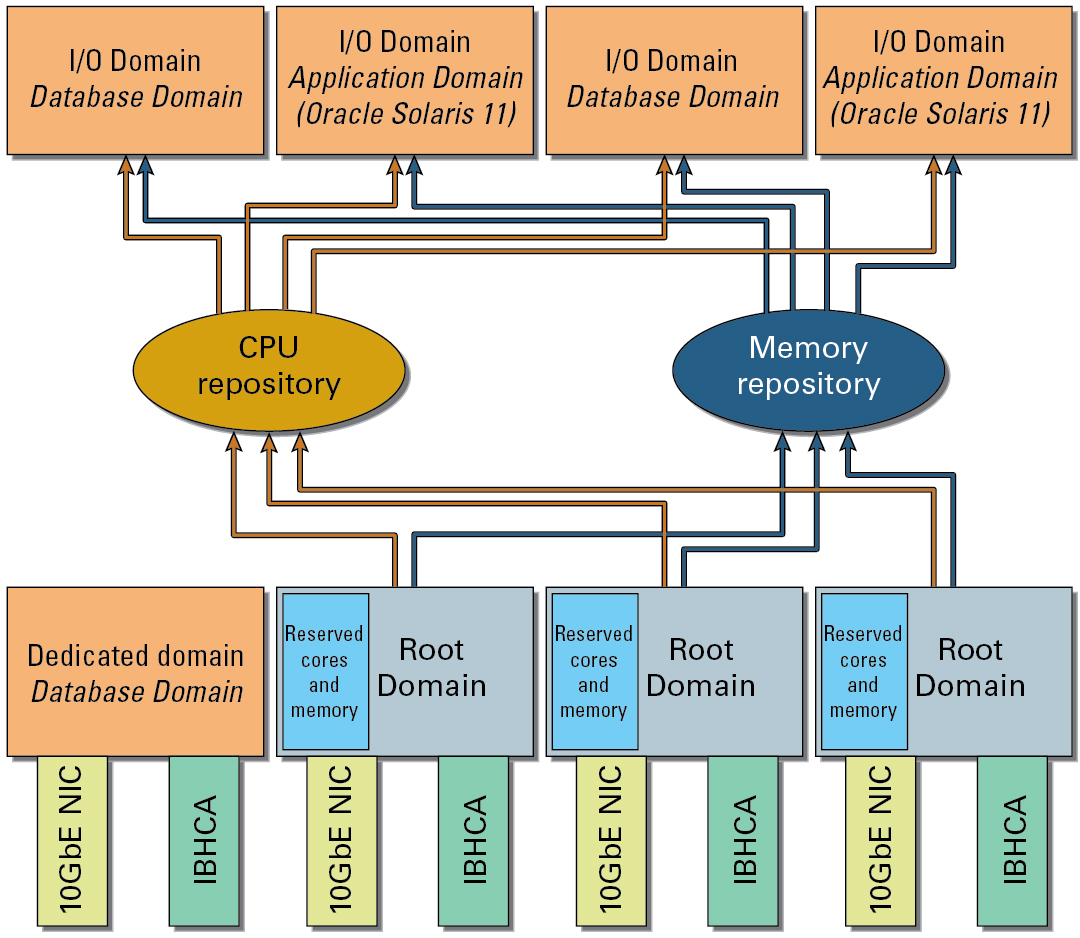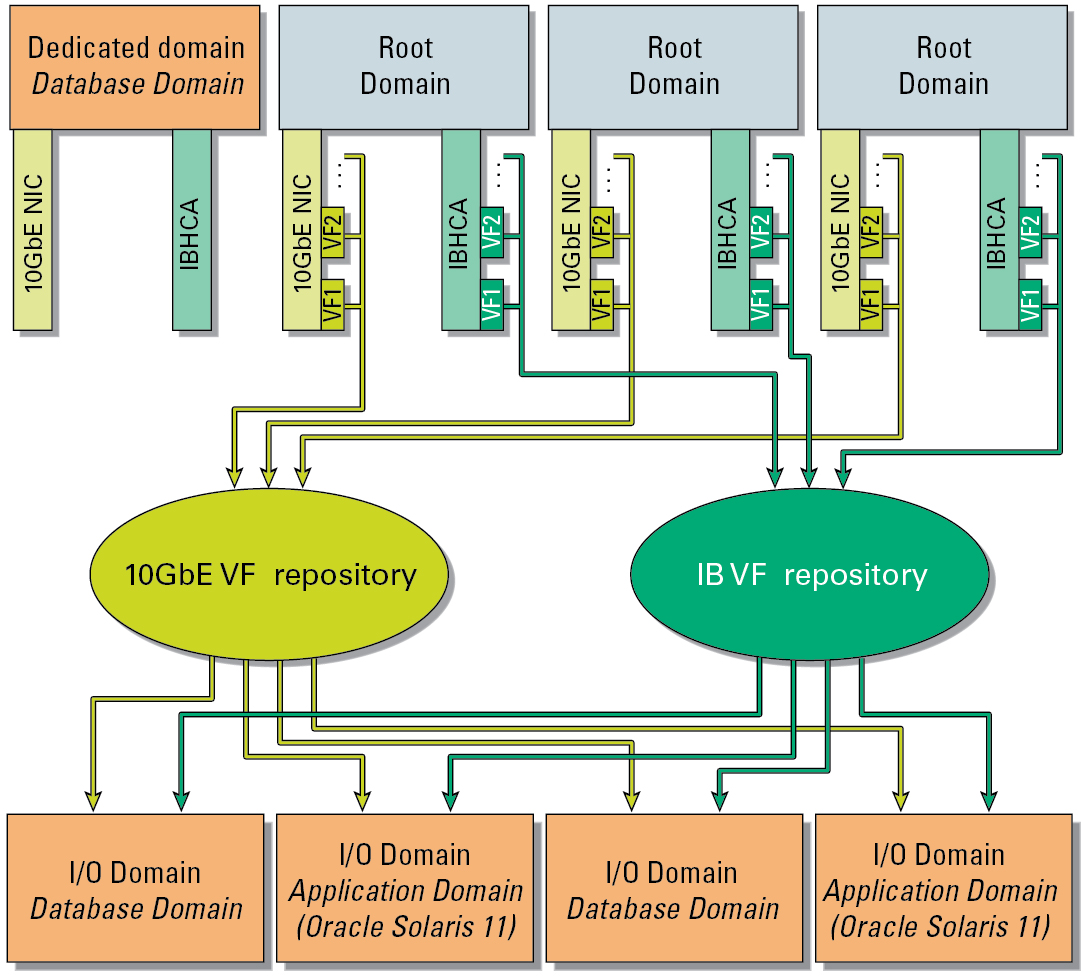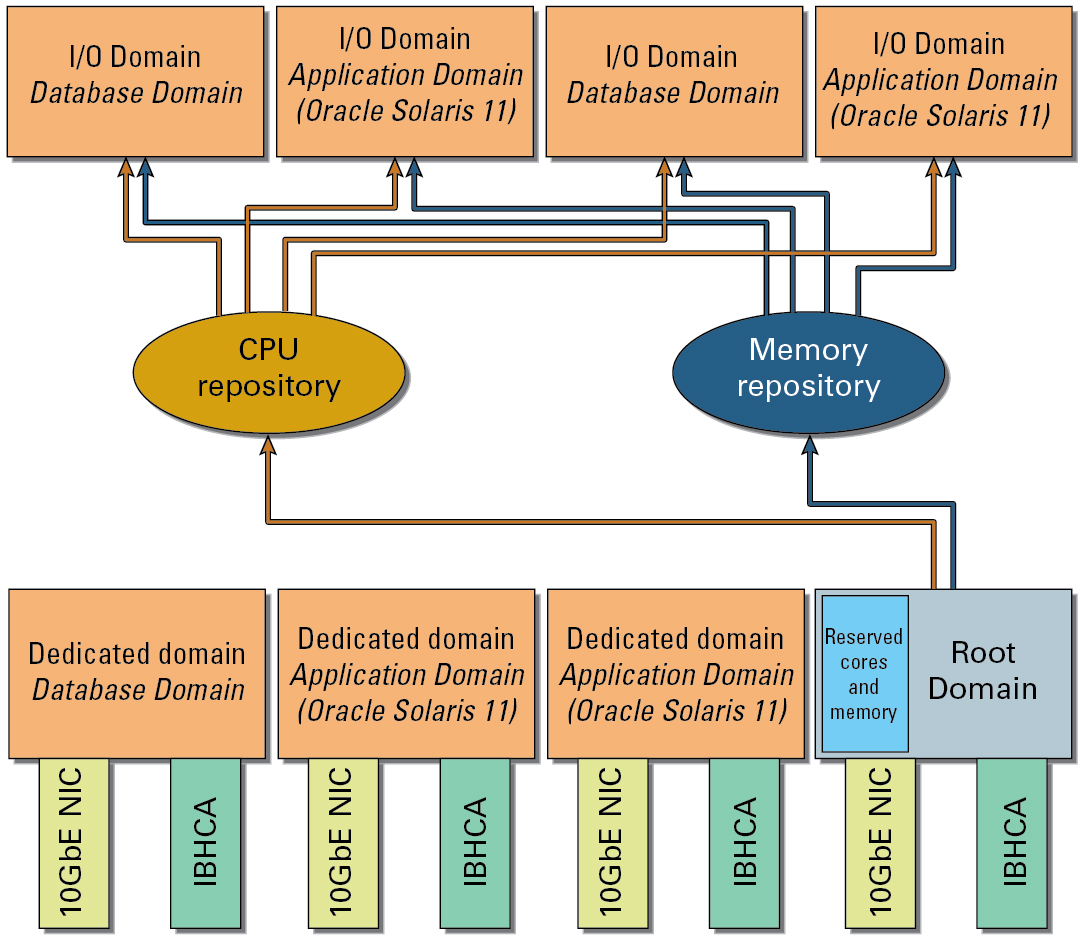I/O Domains
I/O Domains are SR-IOV type domains that you can dynamically deploy or delete any time over the life cycle of the system. You can easily administer I/O Domains using the browser-based SuperCluster Virtual Assistant. For additional details about administering I/O Domains, refer to the Oracle I/O Domain Administration Guide.
I/O Domains use virtual functions (VFs) that are provided by the Root Domain PFs.
When I/O Domains are created, they are specified as one of these I/O Domain types:
-
Application I/O Domain running Oracle Solaris 11
-
Database I/O Domain
-
Database Zone I/O Domain
The CPU and memory resources owned by an I/O Domain are assigned from the CPU and memory repositories (the cores and memory released from Root Domains on the system) when an I/O Domain is created, as shown in this diagram.

You use the SuperCluster Virtual Assistant to assign the CPU and memory resources to the I/O Domains, based on the amount of CPU and memory resources that you want to assign to each I/O Domain and the total amount of CPU and memory resources available in the CPU and memory repositories. Refer to the I/O Domain Administration Guide for more information.
Similarly, the IB VFs and 10GbE VFs owned by the I/O Domains come from the IB VF and 10GbE VF repositories (the IB VFs and 10GbE VFs released from Root Domains on the system), as shown in the following graphic.

The number and size of the I/O Domains that you can create depends on several factors, including the amount of CPU and memory resources that are available in the CPU and memory repositories. However, while it is useful to know the total amount of resources that are parked in the repositories, it does not necessarily translate into the maximum number of I/O Domains that you can create for your system. In addition, you should not create an I/O Domain that uses more than one socket's worth of resources.
The SuperCluster Virtual Assistant keeps track of available and used resources, simplifying the administration of I/O Domains and resources.
Note - The following examples describe how resources can be divided up between domains using percentages to make the conceptual information easier to understand. However, you actually divide CPU and memory resources between domains at a socket granularity or core granularity level. Refer to the Oracle SuperCluster M8 and SuperCluster M7 Administration Guide for more information.
As an example configuration showing how you might assign CPU and memory resources to each domain, assume that you have a domain configuration where one of the domains is a Root Domain, and the other three domains are dedicated domains, as shown in the following figure.

Even though dedicated domains and Root Domains are all shown as equal-sized domains in the preceding figure, that does not mean that CPU and memory resources must be split evenly across all four domains (where each domain is allocated 25% of the CPU and memory resources). Using information that you provide in the Configuration Worksheets, you can request different sizes of CPU and memory resources for each domain when your SuperCluster M8 or SuperCluster M7 is initially installed.
For example, you can request that each dedicated domain have 30% of the CPU and memory resources (for a total of 90% of the CPU cores and memory resources allocated to the three dedicated domains), and the remaining 10% allocated to the single Root Domain. Having this configuration means that only 10% of the CPU core and memory resources are available for I/O Domains to pull from the CPU and memory repositories. However, you can also request that some of the resources from the dedicated domains be parked at the time of the initial installation of your system, which further increases the amount of CPU and memory resources available for I/O Domains to pull from the repositories.
You can also use the CPU/Memory tool after the initial installation to resize the amount of CPU and memory resources used by the existing domains, depending on the configuration that you chose at the time of your initial installation:
-
If all of the domains on your compute server are dedicated domains, you can use the CPU/Memory tool to resize the amount of CPU and memory resources used by those domains.
-
If you have a mixture of dedicated domains and Root Domains on your compute server:
-
For the dedicated domains, you can use the CPU/Memory tool to resize the amount of CPU and memory resources used by those dedicated domains. You can also use the tool to park some of the CPU and memory resources from the dedicated domains, which parks those resources in the CPU and Memory repositories, making them available for the I/O Domains.
-
For the Root Domains, you cannot resize the amount of CPU and memory resources for any of the Root Domains after the initial installation. Whatever resources that you asked to have assigned to the Root Domains at the time of initial installation are set and cannot be changed unless you have the Oracle installer come back out to your site to reconfigure your system.
-
Refer to the Oracle SuperCluster M8 and SuperCluster M7 Administration Guide for more information.
Assume you have a mixture of dedicated domains and Root Domains as mentioned earlier, where each dedicated domain has 30% of the CPU and memory resources (total of 90% resources allocated to dedicated domains), and the remaining 10% allocated to the Root Domain. You can then make the following changes to the resource allocation, depending on your situation:
-
If you are satisfied with the amount of CPU and memory resources allocated to the Root Domain, but you find that one dedicated domain needs more resources while another needs less, you can reallocate the resources between the three dedicated domains (for example, having 40% for the first dedicated domain, 30% for the second, and 20% for the third), as long as the total amount of resources add up to the total amount available for all the dedicated domains (in this case, 90% of the resources).
-
If you find that the amount of CPU and memory resources allocated to the Root Domain is insufficient, you can park resources from the dedicated domains, which parks those resources in the CPU and Memory repositories, making them available for I/O Domains. For example, if you find that you need 20% of the resources for I/O Domains created through the Root Domain, you can park 10% of the resources from one or more of the dedicated domains, which increases the amount of resources in the CPU and Memory repositories by that amount for the I/O Domains.